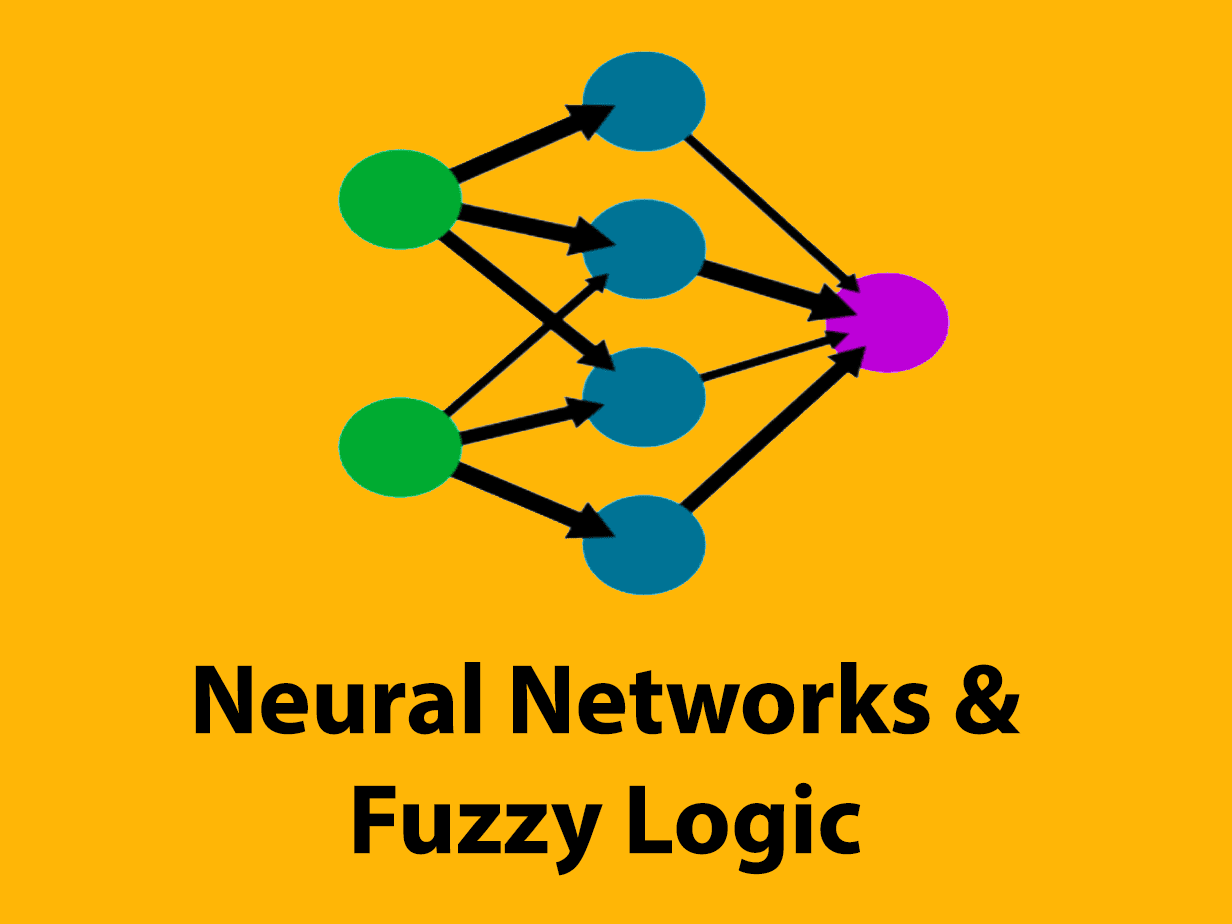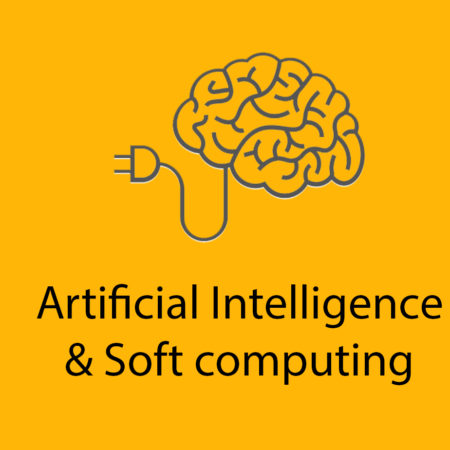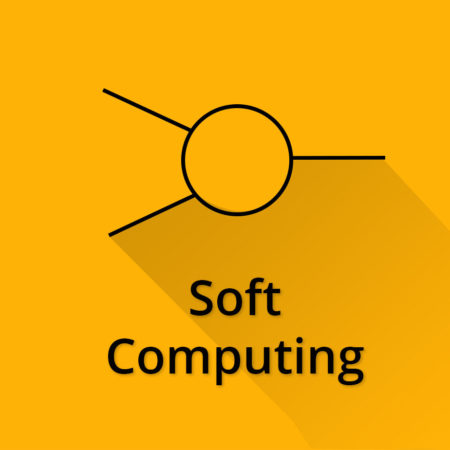Neural networks and Fuzzy Logic
₹1,000.00
₹499.00

-
Index
This is the module with maximum weightage and lengthy concepts & sums! 13 videos on ANN.
- Learning and Types of Learning C
- Soft computing vs Hard computing and Supervised learning vs Unsupervised Learning
- Derivation of Unipolar Continuous Function.
- Derivation of Bipolar Continuous Function
- Self Organizing Maps and KSOMs
- Perceptron Learning (with solved example)
- Backpropagation Network (with solved example)
- Introduction to ANN and structure of ANN
- Activation functions in ANN (Discrete and Continuous)
- Neural Network Architecture
- Hebbs Network/Hebbian Learning (with solved example)
- Linear Separability
- Winners-Takes-All
- Mc-Culloch-Pitts Neural Model
- Linear Vector Quantization (LVQs)
-
FUZZY Logic
9 videos on Fuzzy Logic in Soft Computing.
- Introduction to Fuzzy Logic
- Fuzzification and De-Fuzzification
- Properties and Operation of Crisp and Fuzzy Sets
- Crisp and Fuzzy Sets and Relations
- Fuzzy Membership Function
- Fuzzy Extension Principle
- Lambda Cut/Alpha Cut
- Max-Min Max-Product Fuzzy Composition (with solved example)
- Mamdani Fuzzy Model (Fuzzy Controller) with Solved Example
- Intro to Hybrid Systems
- Neuro-Fuzzy System (Co-Operative and General NFS)
- Fuzzy Inference System
- ANFIS
-
Notes
-
Viva Questions
Neural networks and Fuzzy Logic
Course Objective for the subject Neural networks and Fuzzy Logic are as follows Students will try to familiarize with soft computing concepts.
To introduce the fuzzy logic concepts, fuzzy principles and relations. To Basics of ANN and Learning Algorithms. Ann as function approximation. Genetic Algorithm and its applications to soft computing. Hybrid system usage, application and optimization. Course Outcomes for the subject Soft Computing are as follows Students will be able to List the facts and outline the different process carried out in fuzzy logic, ANN and Genetic Algorithms. Explain the concepts and meta-cognitive of soft computing. Apply Soft computing techniques the solve character recognition, pattern classification, regression and similar problems. Outline facts to identify process/procedures to handle real world problems using soft computing. Evaluate various techniques of soft computing to defend the best working solutions. Design hybrid system to revise the principles of soft computing in various applications.
Module Fuzzy Set Theory consists of the following subtopic as follows Fuzzy Sets: Basic definition and terminology, Basic concepts of fuzzy sets, Fuzzy set operations, Fuzzy relations: Cardinality of fuzzy relations, operations on fuzzy relations, properties of fuzzy relations, Fuzzy composition Fuzzification and Defuzzification: Features of the membership Functions, Fuzzification, Lambda-Cuts for Fuzzy Sets, Lambda-Cuts for Fuzzy Relations, Defuzzification methods.
Module Fuzzy Rules, Reasoning, and Inference System consists of the following subtopic as follows Fuzzy Rules: Fuzzy If-Then Rules, Fuzzy Reasoning Fuzzy Inference System ( FIS): Mamdani FIS, Sugeno FIS, Comparison between , Mamdani and Sugeno FIS.
Module Neural Network-I consists of the following subtopic as follows Introduction: What is a Neural network? Fundamental Concepts, Basic Models of Artificial Neural Networks, Arificial Intelligence and Neural Networks, McCulloch-Pitts Neuron Learning: Error-Correction Learning, Memory based Learning, Hebbian learning, Competitive Learning, Boltzmann Learning Perceprton: Perceprton Learning Rule, Perceptron Learning Algorithm, Perceprton Convergence Theorem, Perceptron learning and Non-separable sets.
Module Neural Networks –II consists of the following subtopic as follows Back propaggation: Multilayered Network Architecture, Back porpagation Algorithm, Practical Consideration in impin Implementing the Back propagation Algorithm. Back propagation and XOR problem. Adaptive resonance Theory: Noise-Saturation Dilemma, Solving the Noise-Saturation Dilemma, Recurrent On-center-Off-surround Networks, Building blocks of Adaptive Resonance, Substrate of resonance, Structural details of the resonance Model, Adaptive Resonance Theory I (ART I), Neurophysiological Evidence for ART Mechanism Character Recognition: Introduction, General Algorithm Architecture for Character Recognition: Binarization, Preprocessing, Filters, Smoothing, Skew Detection and Correction, Slant Correction, Character Normalization, Thinning, Segmentation, Multilingual OCR by Rule-Based Approach and ANN. Rule-Based Approach: Classification, Tests, Rules Artificial Neural Network: Inputs, Outputs, Identification Results of Multilingual OCR.
Module Genetic Algorithm consists of the following subtopic as follows An Introduction to genetic Algorithms: What Are Genetic Algorithms? Robustness of Traditional Optimization and Search Methods, The Goals of Optimization, How Are Genetic Algorithms Different from Traditional Methods?, A Simple Genetic Algorithm Genetic Algorithms at Work—a Simulation by hand, Grist for the Search Mill—Important Similarities, Similarity Templates (Schemata), Learning the Lingo. Genetic Algorithms: Mathematical Foundations Who Shall Live and Who Shall Die? The Fundamental Theorem, Schema Processing at Work: An Example by Hand Revisited, The Two-armed and й-armed Bandit Problem, How Many Schemata Are Processed Usefully? The Building Block Hypothesis, Another Perspective: The Minimal Deceptive Problem, Schemata Revisited: Similarity Templates as Hyperplanes, Implementation of a Genetic Algorithm: Data Structures, Reproduction, Crossover, and Mutation, A Time to Reproduce, a Time to Cross, Get with the Main Program, How Well Does it Work? Mapping Objective Functions to Fitness Form, Fitness Scaling, Codings, A Multiparameter, Mapped, Fixed-Point Coding, Discretization, Constraints. Algorithm for Handwriting Recognition Using GA Generation of Graph, Fitness Function of GA: Deviation between Two Edges, Deviation of a Graph, Crossover: Matching of Points, Generate Adjacency Matrix, Find Paths, Removing and Adding Edges, Generation of Graph Results of Handwriting Recognition: Effect of Genetic Algorithms, Distance Optimization, Style Optimization.
Module Hybrid Computing consists of the following subtopic as follows Introduction, Neuro-Fuzzy Hybrid Systems, Adaptive Neuro-Fuzzy Inference System (ANIFS): Introduction, ANFS Architecture, Hybrid Learning Algorithm, ANFIS as a Universal Approximator, Simulation Examples: Two-input Sinc Function and Three Input Nonlinear Function Genetic Neuro-Hybrid Systems: Properties of Genetic Neuro-Hybrid Systems, genetic Algorithm based Back-propagation Network, Advantages of Neuro-Genetic Hybrids, Genetic Fuzzy Hybrid and Fuzzy Genetic Hybrid Systems Genetic Fuzzy Rule based Systems, Advantages of Genetic Fuzzy Hybrids.
Suggested Text Books for these subject Soft Computing by Mumbai University are as follows S.N. Sivanandan and S.N. Deepa, Principles of Soft Computing, Wiley India, 2007, ISBN: 10: 81- 265-1075-7. J.-S. R. Jang, C. T. Sun, E. Mizutani, Neuro-Fuzzy and Soft Computing, A Computational Approach to Learning and Machine Intelligence, PHI Learning Private Limited-2014. Neural Networks: A Classroom Approach, Satish Kumar, Tata McGraw-Hill Education, 2004/2007. Simon Haykin, Neural Networks A Comprehensive Foundation, Second Edition, Pearson Education-2004. David E. Goldberg, Genetic Algorithms, in search, optimization and Machine Learning, Pearson.
Suggested Reference Books for these subject Soft Computing by Mumbai University are as follows Anupam Shukla, Ritu Tiwari, Rahul Kala, Real Life Applications of Soft Computing, CRC Press, Taylor & Francis Group, 2010.Genetic Algorithms and Genetic Programming Modern Concepts and Practical Applications 2009 Michael Affenzeller, Stephan Winkler, Stefan Wagner, and Andreas Beham, CRC Press Laurene V. Fausett, Fundamentals of Neural Networks: Architectures, Algorithms and Applications, Pearson.
Prepare For Your Placements: https://lastmomenttuitions.com/courses/placement-preparation/
![]()
/ Youtube Channel: https://www.youtube.com/channel/UCGFNZxMqKLsqWERX_N2f08Q
Follow For Latest Updates, Study Tips & More Content!
Course Features
- Lectures 32
- Quizzes 0
- Duration 4 hours
- Skill level All levels
- Language Hindi
- Students 6
- Certificate No
- Assessments Yes




